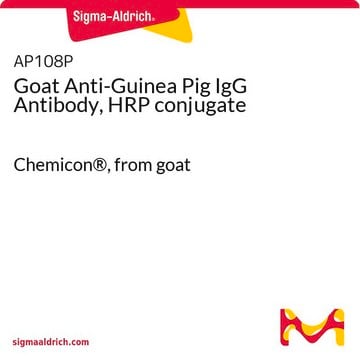F6261
Anti-Guinea Pig IgG (whole molecule)−FITC antibody produced in goat
affinity isolated antibody, buffered aqueous solution
Sinônimo(s):
Goat Anti-Guinea Pig IgG (whole molecule)−Fluorescein isothiocyanate
About This Item
Produtos recomendados
fonte biológica
goat
conjugado
FITC conjugate
forma do anticorpo
affinity isolated antibody
tipo de produto de anticorpo
secondary antibodies
clone
polyclonal
forma
buffered aqueous solution
técnica(s)
direct immunofluorescence: 1:64
temperatura de armazenamento
2-8°C
modificação pós-traducional do alvo
unmodified
Categorias relacionadas
Descrição geral
Anti-Guinea Pig IgG (whole molecule)-FITC antibody is specific for guinea pig IgG subclasses. Goat anti-Mouse IgG is purified by affinity isolation and conjugated to FITC.
The suitability of any secondary antibody to a specific immunodetection application is dependent upon its signal development system configuration. Signal development systems are based upon the chemical conjugation of a signal mediator to the secondary antibody. Major secondary antibody signal systems are color (chromogenic), chemiluminescence or fluorescence based and involve the use of enzymes or high affinity binary systems such as biotin:avidin.
Fluorescein isothiocyanate (FITC) is a fluorescein derivative (fluorochrome) used to tag antibodies, including secondary antibodies, for use in fluorescence-based assays and procedures. FITC excites at 495 nm and emits at 521 nm.
Imunogênio
Aplicação
forma física
Exoneração de responsabilidade
Not finding the right product?
Try our Ferramenta de seleção de produtos.
Código de classe de armazenamento
10 - Combustible liquids
Classe de risco de água (WGK)
WGK 2
Ponto de fulgor (°F)
Not applicable
Ponto de fulgor (°C)
Not applicable
Certificados de análise (COA)
Busque Certificados de análise (COA) digitando o Número do Lote do produto. Os números de lote e remessa podem ser encontrados no rótulo de um produto após a palavra “Lot” ou “Batch”.
Já possui este produto?
Encontre a documentação dos produtos que você adquiriu recentemente na biblioteca de documentos.
Nossa equipe de cientistas tem experiência em todas as áreas de pesquisa, incluindo Life Sciences, ciência de materiais, síntese química, cromatografia, química analítica e muitas outras.
Entre em contato com a assistência técnica








